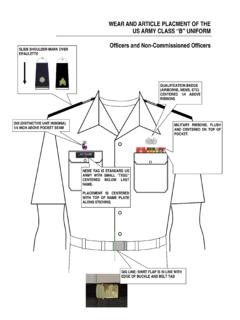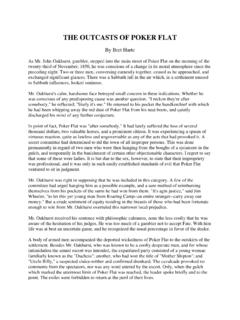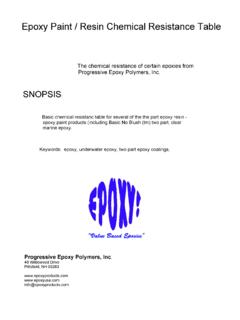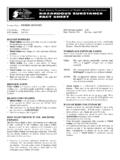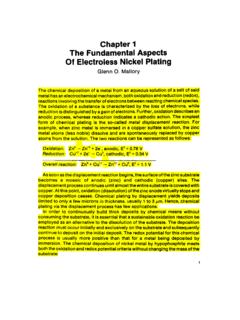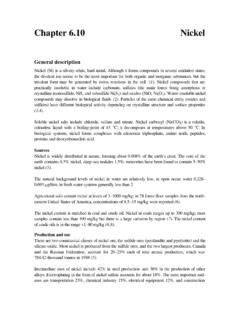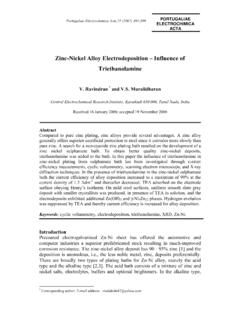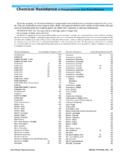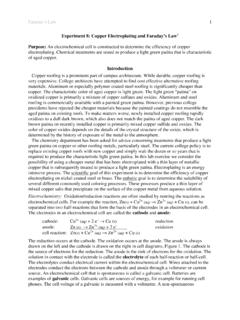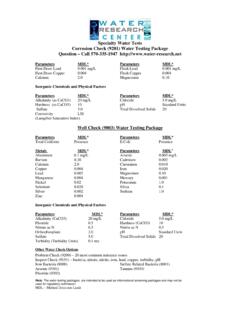Transcription of Exp 18 Percentage and Formula of a Hydrate - HCC
1 1 EXPERIMENT18: Formula of a HydrateMaterials:RingstandRingcrucible tongsLarge evaporating dishHot plateBalanceStirring rodSmall dropper for waterCuSO4 5H2 OUnknowns:MgSO4 XH2O, FeSO4 XH2 OObjective:a)Confirm the Formula of a Hydrate with known )Second, find the Formula of a Hydrate in which the salt Formula is known but not the molar amount chemical compounds,especially inorganic salts, incorporate water into their has a polar structure:it has positively and negatively charged parts within each gives it a strong attraction toward ions in some salts attract and form strong bonds with watermolecules. These salts, when they have absorbed water, are are salts that canform hydrates but which have had all the water driven off, usually by salts are characterized bythe number of moles of water molecules per mole of so-calledwater of hydrationof nickel (II)chloride (NiCl2) is six moles H2O for every one mole of NiCl2. The hydration reaction is shown below. Thehydrate in this reaction is callednickel(II) chloride +6H2 ONiCl2 6H2 OThe Formula of this Hydrate shows the molar amount of water incorporated into the crystal matrix.
2 For mosthydrates the amount of water included in the Formula is only important when trying to measure molar amountsof the salt. You need to know the true Formula weight (molar mass) in order to measure out the mass needed togive a certain number of moles. The chemical importance of the water of hydration is minimal since it can bedriven off by heat or simply dissolve away if the salt is dissolved in water. From the reaction above, nickel (II)chloride hexahydrate (NiCl2 6H2O)the molar mass is g/mol not g/mol. The figure is the molar mass of the anhydrous Prefixes: used to indicate the molar amount of water in hydrated (mono-)2(di-)3(tri-)4(tetra-)5(penta-)6( hexa-)7(hepta-)8(octa-)9 (nona-)10 (deca-)2 Formulas for hydrates are writtenusing a dot convention: a dot is used to separate the Formula of the salt fromthe Formula of the water of hydration. A numerical coefficient gives the molar amount of water included in thehydrate. Hydrates are named using prefixes for the word Hydrate (at right).
3 For example,CuCl2 2H2O iscopper(II) chloride dihydrateandCuSO4 5H2O is copper(II) sulfate pentahydrate. One key point: the dotisnota multiplication sign. When calculating the molar mass youaddthe molar mass of water (multiplied bythe coefficient).An everyday example of hydration is concrete. Concrete is made by mixing Portland cement with water andaggregate materials. The aggregate materials are the gravel and sand that add strength to the final concrete. ThePortland cement is a mixture of calcium silicates, calcium aluminate, calcium aluminoferrite and gypsum. All ofthese chemicals absorb water by hydration. This means that concrete does not dry in a conventional the water mixed with the concrete combines chemicallywith the materials in the cement and theresulting hydrates form a strong matrix that holds the concrete together and makes it interesting example of the value of hydration is the incorporation of hydrated building materials (suchas concrete, gypsum wall board and plaster).
4 The building materials will not rise above the 100 C boiling pointof water until all of the water of hydration has been driven off. This can help keep damage to a minimum untilthe fire can be put out. In the construction business this is known as passive fire this experiment, you will be instructed to determine the mass of a sample of an unknown Hydrate by"difference", using a pre-weighed crucible and cover as the container. The substance will be "dehydrated" byheat and weighed again. The loss of mass represents the mass of water in the original sample, which may beexpressed as Percentage of water of hydration, using the following relationship:To find the Formula of the original Hydrate , you will determine from the preceding data the most anhydrouscompound for the Formula given to you. Form this you can calculate the moles of anhydrous compound in theoriginal sample. From the mass of the water in the original sample, you can calculate the moles of water to onemole of anhydrous salt, as in the 5-to-1 ratio for CuSO4 5H2O this experimentyou will be directed to "heat to constant mass.
5 " Your purpose is to heat the substance untilall of the water is drivenoff. After the first heating, cooling, and weighing, you cannot tell if all water has beenremoved or if some still remains. You therefore must repeat the heating, cooling, and weighing procedure. If thesame mass is reached after the second heating, youmay assume that all water was removed the first time. Ifmass is lost in the second heating, you may be sure that all water was not removed in the first heating, and youare still unsure whether all water was drivenoffin the second heating. Another heating is therefore heating, cooling, and weighing sequence is repeated until two successive duplicateweighingare weighing within is satisfactory for this 1 Assume that heating of a sample ofthe Hydrate of copper sulfate yields of anhydrous coppersulfate. The mass percent of water in the Hydrate would be:Now the ratio of the number of water molecules per Formula unit copper sulfate can be 5H2O4 Example 2A sample of NiSO4 XH2O is heated until no further decrease in mass.
6 The mass of the anhydrous salt the number of water molecules in the Formula of this Hydrate of nickel (II) sulfateand calculate thepercentage of :NiSO4 XH2O NiSO4+XH2O1 mol( g)( )= mol g( g)=63g H2O1 mol(63 g H2O)( )= mol mol H2 Omol ratio= =7mol H2O per mol anhydrous NiSO4 Therefore, the Hydrate formulaisNiSO4 7H2O, nickel (II) sulfate percentageof water in this hydrated saltis calculated as follows:5 ProcedurePARTID ehydration of a hydratea) Place a few small crystals of copper sulfate pentahydrate, CuSO4 5H2O into an evaporating the evaporating dish with crucible tong and plate it on a the evaporating dish gentlywhile stirringfor about 10 minutes. Record your ) After theevaporating dishhas cooled to room temperature, add a few drops of water. Record a clean, dry crucibleand the cover to at least the nearest Place to of the solid unknownhydrate crystals in the crucible and weigh again to the nearest Place the crucible and cover in a triangleover a Bunsen burner.
7 Heat the container and its contentsvigorously with the top slightly open for about 15-20minutes. Allow the crucible to cool (to the touch) and weigh it to the nearest Record this and subsequentweighingin the "constant mass" portion of the report form. If the mass difference between the first and secondheating is greater than , perform a third heating, cooling, and weighing cycle until duplicate masses arereached. The final (constant) mass should be reported as the mass of the container (crucible and cover) plusanhydrous not discard the anhydrous salt in the crucible until your calculations are finished and satisfactory. If they arenot satisfactory, it is possible that you may need to repeat the the mass Percentage of water and the empirical Formula of the : Formula of a HydrateREPORT FORMName _____Instructor _____Date_____PARTIa)Write your observations when the copper Hydrate is heated inevaporating ) Write your observations when water is added to copper anhydrous Number_____1.
8 Mass ofevaporating dish_____ ofevaporating dish+ hydrated salt_____ g3. Mass of hydrated salt:[2]-[1]_____ ofevaporating dish+ anhydrous salt (after heating)first_____ g , second _____ g , third _____ g, fourth _____ g ( if necessary)5. Mass of water lost by hydrated salt:[2]-[4]_____ g6. Mass Percentage of water in hydrated salt_____ %(show calculation)7. Formula mass of anhydrous salt_____ g/mol8. Moles of anhydrous salts:[3] / [7]_____ mol9. Formula mass of water_____ g/mol10. Moles of water in hydrated salt:[5] / [9]_____ mol11. Ratio of moles of water to moles of anhydrous salt:[10] / [8]_____ ratio12. Empirical Formula of hydrated salt_____(hydrated salt Formula )8 EXPERIMENT18 Name:Pre-laboratory Questions and ExercisesDue before lab begins. Answer in space Define the following Water of hydrationb. Constant mass2. A sample of CuSO4 XH2O was heated until all of the water was removed. Calculate thepercentage of water of hydration and the Formula of the Hydrate if the residue after heating Give the correct name for the following:a.
9 CaCl2 2H2O_____b. Cu(NO3)2 H2O_____4. The mass percent of water in a Hydrate of MnCl2is What is the empirical Formula of thehydrate?9 EXPERIMENT18 Name:Post-laboratory Questions and ExercisesDue after completing in space A student had a sample of BaCl2 2H2O and an inert material. He heated a sample until the mass didnot change. From this data, calculate the Percentage of BaCl2 2H2O in the original of crucible + cover = of crucible + cover + unknown sample = of crucible + cover + residue = In the dehydration of hydratedsalt, the sample was slightly moist because of high how the moisture affects the Percentage How can you make sure that all of the water of hydration has been removed? What are the formulas for the following hydrated salts?a. Cobalt(II) chloride hexahydrate_____b. Iron(II) sulfate that a sample of hydratedNiSO4 XH2 Ois reduced in mass to g upon value of X.

